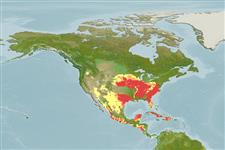Actinopterygii (ray-finned fishes) >
Cyprinodontiformes (Rivulines, killifishes and live bearers) >
Poeciliidae (Poeciliids) > Poeciliinae
Etymology: Gambusia: Gambusia: From the Cuban term, Gambusino, which means "nothing", usually in the context of a joke or a farce. Fishing for gambusinos = when one catches nothing (Ref. 45335); affinis: From the Latin word affinusmeaning related (Ref. 79012).
Environment / Climate / Range
Ecology
Freshwater; brackish; benthopelagic; pH range: 6.0 - 8.0; dH range: 5 - 19; potamodromous. Subtropical; 12°C - 29°C (Ref. 52055), preferred ?; 42°N - 26°N
North and Central America: Mississippi River basin from central Indiana and Illinois in USA south to Gulf of Mexico and Gulf Slope drainages west to Mexico. One of the species with the widest range of introductions which acquired for itself a near pan-global distribution (Ref. 1739). Several countries report adverse ecological impact after introduction.
Size / Weight / Age
Maturity: Lm ? range ? - ? cm
Max length : 5.1 cm TL male/unsexed; (Ref. 50932); 7.0 cm TL (female); common length : 3.9 cm TL male/unsexed; (Ref. 12193); max. reported age: 3 years (Ref. 796)
Dorsal
spines
(total): 0;
Dorsal
soft rays
(total): 7-9;
Anal
spines: 0;
Anal
soft rays: 9 - 10. Origin of dorsal fin opposite 7th anal ray. Length of anal base much less than half distance from caudal. 8 horizontal scale rows between back and abdomen. Ventrals terminate immediately before anal fin. Pelvic fins reach ventrals.
Most abundant in lower reaches of streams (Ref. 44091). Adults inhabit standing to slow-flowing water; most common in vegetated ponds and lakes, backwaters and quiet pools of streams. Found frequently in brackish water (Ref. 5258). Pelagic and surface predatory fish (Ref. 94816). Feed on zooplankton, small insects and detritus (Ref. 5258, 10294). Used as live food for carnivorous aquarium fishes. Viviparous (Ref. 5258, 30578). Effective in mosquito control and widely introduced, but found to compete with indigenous fish and to upset the ecological balance (Ref. 6351).
The species is viviparous (Ref. 5258). Internal fertilization is possible because the anal fin of the male is modified into a copulatory organ. The females carries about 30 alevins and gestation lasts for a period of 24 days (Ref. 6348) to a month (Ref. 30578).
Page, L.M. and B.M. Burr, 1991. A field guide to freshwater fishes of North America north of Mexico. Houghton Mifflin Company, Boston. 432 p. (Ref. 5723)
IUCN Red List Status (Ref. 115185)
CITES (Ref. 94142)
Not Evaluated
Threat to humans
Potential pest
Human uses
Fisheries: minor commercial; aquarium: commercial
Tools
Special reports
Download XML
Internet sources
